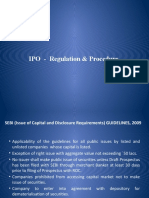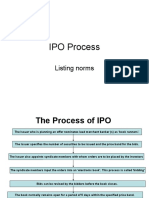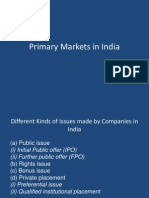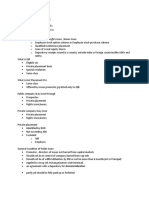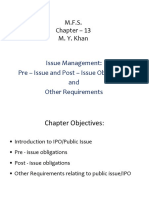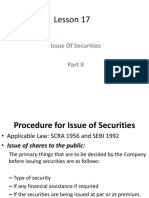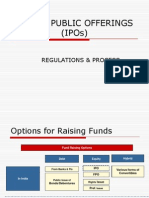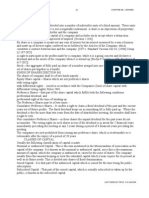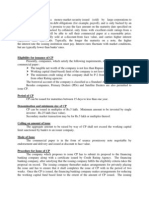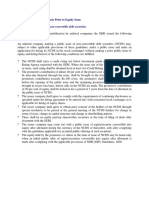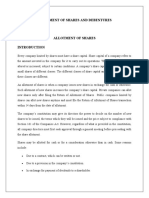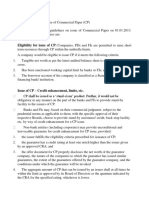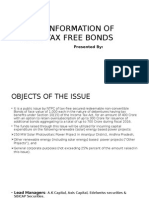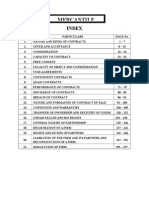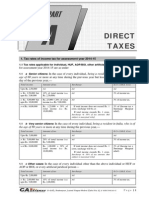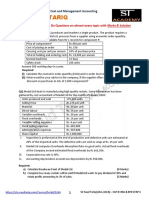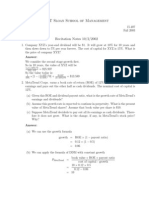Sebi Guidelines CA Final
Sebi Guidelines CA Final
Uploaded by
Bhavin PathakCopyright:
Available Formats
Sebi Guidelines CA Final
Sebi Guidelines CA Final
Uploaded by
Bhavin PathakOriginal Description:
Copyright
Available Formats
Share this document
Did you find this document useful?
Is this content inappropriate?
Copyright:
Available Formats
Sebi Guidelines CA Final
Sebi Guidelines CA Final
Uploaded by
Bhavin PathakCopyright:
Available Formats
SEBI (Issue of Capital and Disclosure Requirements), 2009
SEBI (ICDR), 2009 can be discussed under the following heads:
1. Public Issue by the Companies
2. Rights Issue by existing Listed Companies
3. Bonus Issue by existing Listed Companies
4. Preferential Allotments
5. Issue of Indian Depository Receipts
6. Qualified Institutional Placements and Institutional Placement Programme
7. Issue Of Specified Securities By Small And Medium Enterprises
1. PUBLIC ISSUES
A. Past Track Record of the Company:
Companies with No Past Track Record
Fulfillment of two conditions are required:
1. Pricing shall be based upon Book Building Process
AND
2. Atleast 75% of the Issue size must be allotted to
Qualified Institutional Buyers (QIBs).
Companies having Past Track Record
The issuer can adopt any of the following two methods for
pricing of its issue:
1. Book Building Route
OR
2. Fixed Price Route
A company shall be deemed to have a past track record if ALL of the following conditions are fulfilled:
Net Tangible Assets after providing for depreciation and impairment > Rs. 3 crores in preceding 3 years of 12 months
each.
Monetary Assets < 50% of Net Tangible Assets. However, if monetary assets > 50% of Net Tangible Assets, then the
issuer company shall make a firm declaration to utilize such excess for its projects or business, after realization
thereof.
o Monetary Assets These are those assets whose value is fixed by contractual terms. For Example: Trade
Receivables, Accounts Receivables etc.
Net operating Profit after Tax (NOPAT) > Rs. 15 crores in 3 preceding years out of total of 5 preceding years of 12
months each.
Net Worth > Rs. 1 crore in preceding 3 full years each.
o Net Worth = Paid Up Share Capital (+) Reserves [excluding Revaluation Reserve] (+) Securities Premium
A/c () Miscellaneous Expenditure () Profit and Loss Account [Debit Balance]
[Proposed Issue (+) Previous Issue] in the same Financial Year < 5 (x) Net Worth on Last Balance Sheet Date
In case of change of name of the company in the last one year, then at least 50% of the revenue of the previous
financial year should be from the activity indicated by the new name.
B. No. of prospective allottees > 1000. [SEBI may relax this condition]
C. Credit Rating from recognized agencies is required.
D. No pendency with respect to conversion of debt instruments be existing. [However, if similar benefits are reserved for persons
holding such convertible debt instruments, then public issue is permissible.]
PRICING OF THE ISSUE
Face Value Per Share
Issue Price Per Share
> Rs. 500
Can be kept between Rs. 1/- share to Rs. 10/- share
< Rs. 500
SHALL be Rs. 10/- share
The Issuer shall mandatorily disclose the following in the offer document: The Issue Price per share is Rs. X times of Face
Value per share.
SEBI has clarified that the requirement of fixing Face Value per share shall not be applicable to the following;
Government Company
An statutory authority or corporation
Any special purpose vehicle which is engaged in Infrastructure sector.
Page 1
GUIDELINES FOR PRICE BAND
The price of the issue is determined subsequent to receiving of price bids from the public. Whenever offer document is
drafted, instead of quoting an absolute amount of Issue Price, a range of price is given, and such range is known as PRICE
BAND. Whenever pricing of IPO is done by Book Building Process, the companies are required to disclose the price band in
the offer document and other filings made by the company.
The Price Band would be having two prices namely; (a) Floor Price and (b) Cap Price. The lower range of such Price Band is
known as Floor Price and the upper range is known as Cap Price.
PRICE BAND - As per SEBI Regulations, the Cap on Price Band shall not be more than 120% of the Floor Price, i,e. Cap
Price < 120% of Floor Price
SEBI has further mandated that the floor price cannot be less than the face value of specified securities.
ANNOUNCEMENT ABOUT PRICES
Either
In the Prospectus or Offer Document.
Or
The Price shall be physically announced in the following manner:
(a) In case of IPO, at least 5 working days before the opening of the offer.
(b) In case of FPO, at least 1 working day before the opening of the offer.
DIFFERENTIAL PRICING
It is permissible to price the issue for different categories of investors differentially.
Retail Individual Investors
Anchor Investors
Types of Investors
Description
Those Individual Investors who are investing These are the investors who are investing > Rs. 10
upto Rs. 2 lakhs in a company.
crores in a company.
They include High Net worth individuals (HNIs),
QIBs etc.
The price of shares can be lower than the The issue price shall not be lower than the price
Pricing
price offered to others. However, such being offered to others
difference cannot be more than 10% of the
price under allotment.
In case of composite issue (i.e. public issue with rights issue), the issue price of rights issue can be lower than the issue price
being offered to others.
CONDITIONS FOR PROMOTERS CONTRIBUTION
Minimum 20% contribution in total Post Issue capital of the company.
Lock-in-period of 3 years for promoters contribution from the date of allotment.
Lock-in-period of 1 year for excess of promoters contribution over minimum contribution.
No restriction about the following:
o Pledging of promoters shares
o Transfer of shares towards promoters contribution within promoters themselves.
In case the securities are acquired by the promoters in the preceding year at a price lower than the pricing of IPO,
then the promoter shall be required to bring in differential amount at the time of IPO towards its contribution in the
company.
2. Rights Issue By Existing Listed Companies (Right of Pre-emption)
Time Period for keeping the Issue Open
Maximum Period 30 days
Minimum Period 15 days
No right issue can be made, pending conversion of debt instruments unless same benefit is reserved for them.
Letter of offer for right issue shall be dispatched to each and every existing shareholder with the necessary details.
If the Letter of offer is not received by any existing shareholder, then he/ she can apply on a plain paper for such
shares, by providing all the necessary details.
Advertisement by mode of Public Notice shall have to be given: (i) In English newspaper having nationwide
circulation, (ii) In Hindi newspaper having nationwide circulation, and (iii) In Regional newspaper having wide
circulation
Page 2
3. Bonus Issue By Existing Listed Companies
A. All of the following conditions need to be complied with:
AOA must permit bonus issue. If the articles are silent, then shareholders approval through SR will be required.
Only Revenue reserves can be utilized for making bonus issues. However, realized capital reserves can be utilized
for bonus issues.
Securities Premium can be used as per provisions of Section 52 of the Companies Act, 2013 (Earlier Section 78 of
the Companies Act, 1956)
No partly paid-up shares should exist.
No bonus issue can be made, pending conversion of debt instruments unless same benefit is reserved for them.
There should have been no default in repayment of statutory dues, employee dues and repayment of principal and
interest on fixed deposits and debt securities.
B. Bonus issue once declared cannot be withdrawn without the consent of shareholders.
C. Decision for Bonus Issue SHALL be implemented in the following manner:
Within 15 days from the passing of Board Resolution, if shareholders approval is not required;
Within 2 months from the passing of Board Resolution, if shareholders approval is required;
Further, as per SEBI mandate, bonus shares shall be issued within 6 months from the date of passing of Board Resolution.
4. Guidelines for Preferential Issue
A. Meaning Allotment of shares and securities to certain categories of investors on preferential basis.
B. Conditions to be complied with by Listed Companies
Special Resolution must be passed by the Shareholders
Securities must be held in Dematerialized mode.
PAN of prospective allottees must be available
C. Pricing for Preferential Allotment
Companies Listed for > 2 weeks but < Companies actually completes Companies Listed for > 26 weeks
26 weeks
listing period for = 26 weeks
Pricing shall not be less than higher Price per share shall be Pricing shall not be less than higher of
of the following:
recomputed and the difference, if the following:
a. The average of weekly high any, shall be brought in by
a. The average of weekly high and
and low prices of the actual concerned shareholder.
low prices of the preceding 26
period of listing; OR
weeks; OR
b. The average of weekly high If the difference is on a lower side,
b. The average of weekly high and
and low prices of the then the company shall not refund
low prices of the preceding 2
to the concerned shareholder.
preceding 2 weeks
weeks
D. Lock-in Period
Lock-in period
Case
If shares are allotted on preferential basis, 1 year from the date of allotment as per SEBI Mandate.
because of Corporate Debt Restructuring
Framework, prescribed by RBI
If shares are partly paid-up and are allotted to 1 year from the date of allotment and shall expire on the date, ending
other than promoters
on 1 year from the date on which they become fully paid-up.
3 years from the date of allotment
If shares are allotted to promoters
E. Non-applicability of Pricing Guidelines
Preferential Allotment made pursuant to Section 391 to 394 of the Companies Act, 1956.
Preferential Allotment made pursuant to scheme ordered by BIFR.
5. Issue of Indian Depository Receipts (IDRs)
A. Section 390 of the Companies Act, 2013 (Section 605A of Co. Act, 1956), states that a company incorporated outside
India or to be incorporated outside India, can issue Indian Depository Receipts after fulfilling prescribed conditions.
B. The prescribed conditions are:
Issue size > Rs. 50 crores
Track Record of having divisible profits in at least 3 preceding years out of 5 preceding years.
Market capitalization > USD 100 million in its home country.
Net worth > USD 15 million in its home country
No prohibition in the country to access capital markets.
Page 3
6. Qualified Institutional Placements and Institutional Placement Programme
Institutional Placement Programme
Qualified Institutional Placements
Issue Size < Rs. 250 crores: at least 2 QIB Allottees
Minimum Allottees 10
Issue Size > Rs. 250 crores: at least 5 QIB Allottees
Special Resolution needs to be passed
Approval from Stock Exchange is required
Special Resolution needs to be passed
Institutions belonging to same group or under same
Approval from Stock Exchange is required
control, shall not be counted as multiple allottees.
Institutions belonging to same group or under same
control, shall not be counted as multiple allottees.
Special Points
Partly paid up shares cannot be issued under these programmes.
In case of over subscription, allotment of not more than 10% of the offer size shall be made by the seller.
Pricing SHALL be made on the basis of average of weekly high and low prices of preceding 2 weeks.
Lock-in period shall be one year from the date of allotment.
7. Issue Of Specified Securities By Small And Medium Enterprises (SME) [Chapter XB of SEBI (ICDR) Regulations, 2009]
Applicability for Issuer:
If, Post-Issue Face Value of Capital
Then,
< Rs. 10 Crores
Issuer SHALL issue its specified securities in accordance with provisions of this Chapter
> Rs. 10 Crores and < Rs. 25 Crores
Issuer MAY also issue its specified securities in accordance with provisions of this Chapter
The specified securities shall be listed on SME Exchange AND
Where any listed issuer issues specified securities in accordance with provisions of this Chapter it shall migrate the specified
securities already listed on any recognized stock exchange/s to the SME exchange.
"SME exchange" means a trading platform of a recognized stock exchange having nationwide trading terminals permitted by the Board
to list the specified securities issued in accordance with this Chapter and includes a stock exchange granted recognition for this
purpose but does not include the Main Board.
Mandatory Minimums Prescribed:
Application Value
Allottees
> Rs. 1 Lakh per application
> 50
Underwriting by merchant bankers and underwriters
The issuer in consultation with merchant banker may appoint underwriters/ other nominated investors.
The issue shall be 100% underwritten, out of which the merchant banker(s) itself shall underwrite > 15% of the issue size
If other underwriters fail to fulfil their underwriting obligations or other nominated investors fail to subscribe to unsubscribed
portion, the merchant banker shall fulfil the underwriting obligations.
The underwriters other than the merchant banker and the nominated investors, who have entered into an agreement for
subscribing to the issue in case of under-subscription, shall not subscribe to the issue made under this Chapter in any
manner except for fulfilling their obligations under their respective agreements with the merchant banker in this regard.
All the underwriting and subscription arrangements made by the merchant banker shall be disclosed in the offer document.
The merchant banker shall file an undertaking to the Board that the issue has been 100% underwritten along with the list of
underwriters and nominated investors indicating the extent of underwriting or subscriptions commitment made by them, one
day before the opening of issue.
Migration to Main Board
"Main Board" means a recognized stock exchange having nationwide trading terminals, other than SME exchange;
If specified securities are listed on a SME Issuer, MAY migrate its BY passing Special Resolution through Postal Ballot
Exchange and post issue face value specified securities to Main
capital is > Rs. 10 Crores and < Rs. 25 Board
Shareholders other than promoters shall be counted.
Crores
Votes in Favour > 2 (x) Votes Against
If specified securities are listed on a SME Issuer, SHALL migrate its No Further Issue unless:
Exchange and post issue face value specified securities to Main 1. Shareholders other than promoters shall be counted.
capital is likely to increase beyond Rs. 25 Board subject to fulfillment 2. Votes in Favour > 2 (x) Votes Against
3. In-Principle Approval has been obtained
Crores DUE TO rights issue, preferential of Main Board criteria
issue, bonus issue, etc.
Page 4
You might also like
- Neoclassical Theory of The State Summary (North)Document3 pagesNeoclassical Theory of The State Summary (North)Guille FranciscoNo ratings yet
- Initial Public Offer (Ipo)Document30 pagesInitial Public Offer (Ipo)Shruti AshokNo ratings yet
- IPO - Regulation & ProcedureDocument49 pagesIPO - Regulation & Procedureharnav5No ratings yet
- Raising Equity Funds: - Public Issue - Rights Issue - Bonus Issue - Private PlacementDocument33 pagesRaising Equity Funds: - Public Issue - Rights Issue - Bonus Issue - Private PlacementPallav KumarNo ratings yet
- IPO of Shares Through Book Building': Corporate Secretarial Study Circle, Sewree, July 4, 2007Document61 pagesIPO of Shares Through Book Building': Corporate Secretarial Study Circle, Sewree, July 4, 2007Nishant MishraNo ratings yet
- Mechant Banking Cha-2 by Saidul AlamDocument7 pagesMechant Banking Cha-2 by Saidul AlamSaidul AlamNo ratings yet
- Listing in BseDocument4 pagesListing in BseavinashgajanurNo ratings yet
- Sebi (Icdr)Document7 pagesSebi (Icdr)hareshmsNo ratings yet
- Issue of Shares - Unit 2Document31 pagesIssue of Shares - Unit 2BharathNo ratings yet
- IPO Process: Listing NormsDocument16 pagesIPO Process: Listing NormsraghuchanderjointNo ratings yet
- VND - Openxmlformats Officedocument - Presentationml.presentation&rendition 1 1Document28 pagesVND - Openxmlformats Officedocument - Presentationml.presentation&rendition 1 1nazreenaliya17No ratings yet
- IPO Process in India An OverviewDocument15 pagesIPO Process in India An OverviewYash SonkarNo ratings yet
- Securities Market: Dr. Rana Singh 9811828987Document52 pagesSecurities Market: Dr. Rana Singh 9811828987Biswabhusan PradhanNo ratings yet
- Primary Markets in IndiaDocument50 pagesPrimary Markets in IndiaRaman RandhawaNo ratings yet
- What Is A Preferential Issue? Select Group of People Private Placement Basis Does Not IncludeDocument6 pagesWhat Is A Preferential Issue? Select Group of People Private Placement Basis Does Not IncludeShashank EashwarNo ratings yet
- M.F.S. Chapter - 13 M. Y. Khan: Issue Management: Pre - Issue and Post - Issue Obligations and Other RequirementsDocument20 pagesM.F.S. Chapter - 13 M. Y. Khan: Issue Management: Pre - Issue and Post - Issue Obligations and Other RequirementsTabiya WaniNo ratings yet
- IPO-Initial Public Offer: By: Vibha MittalDocument49 pagesIPO-Initial Public Offer: By: Vibha MittalVibha MittalNo ratings yet
- Eligibility Norms For IPODocument5 pagesEligibility Norms For IPOdharmeshduvaNo ratings yet
- Stocks and Commodity Market Operations (MBA 826) : Pricing of Public Issues, Price and Price BandsDocument3 pagesStocks and Commodity Market Operations (MBA 826) : Pricing of Public Issues, Price and Price BandsPriya KansalNo ratings yet
- Session6 7 PublicIssuesDocument27 pagesSession6 7 PublicIssuesKanika AhujaNo ratings yet
- The ICDR Regulations Act, 2009Document11 pagesThe ICDR Regulations Act, 2009Twinkle KillaNo ratings yet
- Part II Chap 17Document39 pagesPart II Chap 17indraniNo ratings yet
- Buy Back of SharesDocument75 pagesBuy Back of Sharesdaxa29No ratings yet
- Initial Public Offerings (Ipos) : Regulations & ProcessDocument43 pagesInitial Public Offerings (Ipos) : Regulations & ProcessNilesh MandlikNo ratings yet
- SEBI Issue of Capital & Disclosure Requirement (2009) & SEBI (Intermediaries) Regulation Act (2008)Document30 pagesSEBI Issue of Capital & Disclosure Requirement (2009) & SEBI (Intermediaries) Regulation Act (2008)jainpratik092No ratings yet
- MBDocument5 pagesMBShatakshi ShrivastavaNo ratings yet
- Investment BankingDocument74 pagesInvestment Bankingjoecool9969No ratings yet
- Sebi (Icdr), 2018Document63 pagesSebi (Icdr), 2018Vedant KshatriyaNo ratings yet
- Primary MarketDocument47 pagesPrimary MarketShruti JainNo ratings yet
- WLC Chapter 06 - SharesDocument10 pagesWLC Chapter 06 - SharesKevin KibetNo ratings yet
- NCFM Update 2Document8 pagesNCFM Update 2Manoj GuptaNo ratings yet
- Initial Public Offering (IPO)Document5 pagesInitial Public Offering (IPO)Sarvepalli JwalachaitanyakumarNo ratings yet
- Unit - 1Document89 pagesUnit - 1sarangNo ratings yet
- Buy Back of Securities ObjectivesDocument21 pagesBuy Back of Securities ObjectivesArchana KhapreNo ratings yet
- Primary MarketDocument16 pagesPrimary Marketmanisha guptaNo ratings yet
- Buybacks and DelistingDocument23 pagesBuybacks and DelistingKushal Adeshra100% (2)
- Note On Public IssueDocument9 pagesNote On Public IssueKrish KalraNo ratings yet
- 3 ChapDocument4 pages3 ChapSuhani AngelNo ratings yet
- Securities Market: An OverviewDocument42 pagesSecurities Market: An OverviewVidhiDesaiDoshiNo ratings yet
- Eligibility For Issuance of CPDocument2 pagesEligibility For Issuance of CPsadathnooriNo ratings yet
- SEBI Guidelines For Public IssueDocument28 pagesSEBI Guidelines For Public IssueSuraj KumarNo ratings yet
- SebiDocument7 pagesSebiAbhijeit BhosaleNo ratings yet
- Fund Raising & Overview of IPO: Sharing NTPC ExperienceDocument38 pagesFund Raising & Overview of IPO: Sharing NTPC ExperienceSamNo ratings yet
- Public Issue and Listing of Non-Convertible Debt SecuritiesDocument1 pagePublic Issue and Listing of Non-Convertible Debt SecuritiesKhushiNo ratings yet
- SEBI - GuidelinesDocument38 pagesSEBI - GuidelinesBalajiNo ratings yet
- What Is Commercial Paper?Document13 pagesWhat Is Commercial Paper?Dr. Amit JainNo ratings yet
- Session 10 - Domestic Issue ManagementDocument72 pagesSession 10 - Domestic Issue ManagementK RameshNo ratings yet
- 2 Primary MarketsDocument42 pages2 Primary Marketssatya123b8101No ratings yet
- Issue: EquityDocument19 pagesIssue: EquitySurajSureshNo ratings yet
- 1) SEBI Issue of Capital and Disclosure Requirements (ICDR) Regulations 2009Document12 pages1) SEBI Issue of Capital and Disclosure Requirements (ICDR) Regulations 2009Shasha GuptaNo ratings yet
- Investment BankingDocument17 pagesInvestment BankingAnkitNo ratings yet
- Stock MarketDocument26 pagesStock MarketBalajiNo ratings yet
- Allotment of Shares and DebenturesDocument15 pagesAllotment of Shares and DebenturesNidharshanaa V RNo ratings yet
- Saibaan Comprehensive PresentationDocument61 pagesSaibaan Comprehensive PresentationTalha SiddiquiNo ratings yet
- New Guidelines For Issue of Commercial PaperDocument3 pagesNew Guidelines For Issue of Commercial PaperFalguni MathewsNo ratings yet
- By-Rahul Bansal Taureq Walizada Ayush Singhal Vasvi ArenDocument25 pagesBy-Rahul Bansal Taureq Walizada Ayush Singhal Vasvi Arenayush_singhal27No ratings yet
- NTPCDocument19 pagesNTPCamritNo ratings yet
- Dividend Growth Investing: A Step-by-Step Guide to Building a Dividend Portfolio for Early RetirementFrom EverandDividend Growth Investing: A Step-by-Step Guide to Building a Dividend Portfolio for Early RetirementNo ratings yet
- Index-CPT LawDocument1 pageIndex-CPT LawBhavin PathakNo ratings yet
- 13 Audit Notes For CA Final by CA Ashish GoyalDocument159 pages13 Audit Notes For CA Final by CA Ashish GoyalSuhag Patel100% (3)
- Gurukripa's Guideline Answers To May 2015 Exam Questions CA Final - Direct TaxesDocument16 pagesGurukripa's Guideline Answers To May 2015 Exam Questions CA Final - Direct TaxesBhavin PathakNo ratings yet
- Computation of Total Income and Tax Payable PDFDocument106 pagesComputation of Total Income and Tax Payable PDFChandru JothirajNo ratings yet
- Amendment For AY 2014-15 (Direct and Indirect Taxes)Document54 pagesAmendment For AY 2014-15 (Direct and Indirect Taxes)Bhavin PathakNo ratings yet
- Accounting StandardsDocument45 pagesAccounting StandardsBhavin PathakNo ratings yet
- GIFT - CAF 8 Master Questions With Solutions & Marks - Caf 8 Sir Saud Tariq ST AcademyDocument36 pagesGIFT - CAF 8 Master Questions With Solutions & Marks - Caf 8 Sir Saud Tariq ST AcademyShehrozSTNo ratings yet
- 03rec3 ExerciseDocument2 pages03rec3 Exercisejunaid1626No ratings yet
- Backflush Costing 1 - Lecture Notes 1, 2 Backflush Costing 1 - Lecture Notes 1, 2Document4 pagesBackflush Costing 1 - Lecture Notes 1, 2 Backflush Costing 1 - Lecture Notes 1, 2Prime MarquezNo ratings yet
- Case... Phuket Beach HotelDocument3 pagesCase... Phuket Beach HotelSanjay Kumar JainNo ratings yet
- Royal Mail Business-Price-Guide-March-2024-V1Document43 pagesRoyal Mail Business-Price-Guide-March-2024-V1ahussainNo ratings yet
- 09 Paper Records Medium BainDocument8 pages09 Paper Records Medium BainkjhgfdyewqNo ratings yet
- Corporate Social Responsibility Research in Accounting WordDocument17 pagesCorporate Social Responsibility Research in Accounting Wordpuspa100% (1)
- Module 5 CANVASDocument9 pagesModule 5 CANVASMon RamNo ratings yet
- Negotiable Instruments Review ProblemsDocument4 pagesNegotiable Instruments Review ProblemsNadine Diamante100% (1)
- CH 13Document5 pagesCH 13fikeNo ratings yet
- Commerce SolutionsDocument55 pagesCommerce SolutionsMike ChindaNo ratings yet
- Russian Mafia PaperDocument6 pagesRussian Mafia PaperJuan RinconNo ratings yet
- Detailed EstimateDocument3 pagesDetailed EstimateKoreenNo ratings yet
- P54 QabDocument7 pagesP54 QabAbbas ZainyNo ratings yet
- 3013734Document2 pages3013734GauriGanNo ratings yet
- The Ideas That I Trade by & Space WarsDocument102 pagesThe Ideas That I Trade by & Space WarsTim GelukNo ratings yet
- Taganito Mining Corporation Vs Cir (Tax1)Document2 pagesTaganito Mining Corporation Vs Cir (Tax1)Ritzchalle Garcia-Oalin0% (1)
- Specimen MS - Paper 2 Edexcel (A) Economics As-LevelDocument17 pagesSpecimen MS - Paper 2 Edexcel (A) Economics As-Leveljames25235235235No ratings yet
- Giberson GlassDocument6 pagesGiberson GlassAyla Dava33% (3)
- Forner Carpet CompanyDocument7 pagesForner Carpet CompanySimranjeet KaurNo ratings yet
- Capital Structure and Leverage AssignmentDocument2 pagesCapital Structure and Leverage AssignmentFaisal FarooquiNo ratings yet
- Raymonds Textile - 4Document131 pagesRaymonds Textile - 4Aditya DoijodeNo ratings yet
- MEC 1st Year Assignments 2018-19 (English) PDFDocument9 pagesMEC 1st Year Assignments 2018-19 (English) PDFTamash MajumdarNo ratings yet
- BE 601 Class 1Document34 pagesBE 601 Class 1Chan DavidNo ratings yet
- A Project Report On Microeconomic Analysis of Coca ColaDocument23 pagesA Project Report On Microeconomic Analysis of Coca ColaAnonymous uZw6hSvkuNo ratings yet
- Club Med A SumeetDocument2 pagesClub Med A SumeetsumeetkantkaulNo ratings yet
- 11 Evolution of Marketing Organization & Marketing AuditDocument38 pages11 Evolution of Marketing Organization & Marketing Auditkanikatekriwal126No ratings yet
- Answer Key Strategic Business Analysis (Formative Quiz 2) Jaypee CompanyDocument2 pagesAnswer Key Strategic Business Analysis (Formative Quiz 2) Jaypee CompanyMerliza JusayanNo ratings yet
- Operating LeverageDocument2 pagesOperating LeveragePankaj2cNo ratings yet


